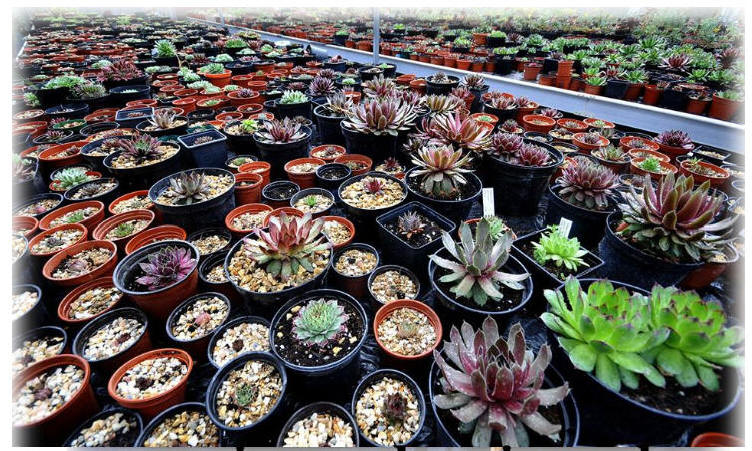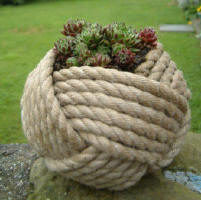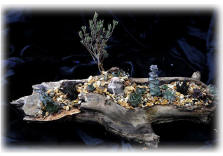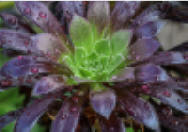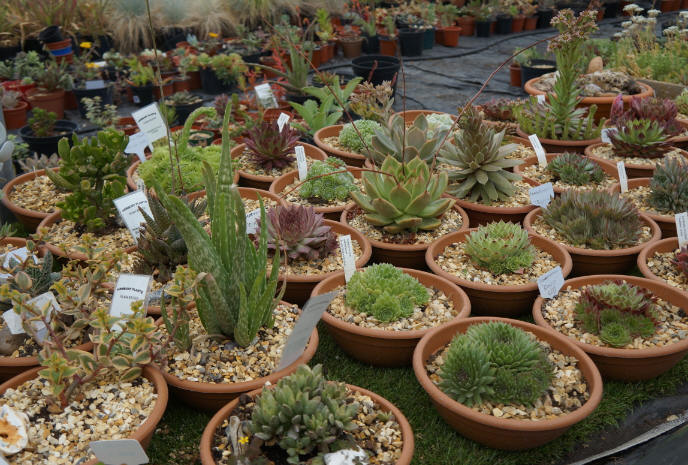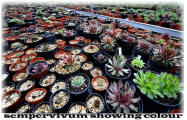If you have bought one of our containers they ideally should be placed where
they get good sun for approximately half a day, with a pair of bricks
underneath at either end this helps with drainage and slows down little
pests getting in.
Outdoor gardens rarely need watering in England keep succulents on the dry
side, although succulents can usually handle more rainfall than theyíd get
in there natural habitat, their roots may rot if the soil stays soggy for
too long so keep an eye on them in very wet weather.
If you need to re-pot any plants that have out grown there places in the
gardens, give their roots superb drainage with a well drained compost with
added 8mm flint.
Autumn and Winter
Very few succulents thrive outdoors where temperatures drop below freezing
(32 degrees F) for extended periods, they hate wet with cold winds it's
often a good idea to cover with fleece or some other temporary protection.
Cold-hardy varieties are primarily fine-leaved and perennial stonecrops
(Sedum sp.)
Hens-and-chicks (Sempervivum sp.)ógenera will tolerate very low temperature
but conversely they donít do well in temperature above 80 degrees, best to
cover with fleece to protect them.
For those of you in areas with cold winters, it would be good practice to
bring your succulent gardens inside before it snows most succulents are
dormant during the winter. They need a period of cold to help them produce
better blooms in the spring and summer.
Temperature
If you grow your succulents indoors year round, they wonít notice much
change in temperature unless they are right by the window. As a general
rule, succulents like to be warm during the summer and cool during the
winter.
If you can, keep the temperature in the summer between 70 and 80 degrees.
During the winter, youíll want your succulents to be a little colder,
between 50 and 60 degrees. Most succulents can tolerate higher and lower
temperatures as well, but those are the ideals.
Generally it is not a good idea to let the succulents get below freezing as
this tends to cause damage to most succulents. Iíve found that having my
plants by the window and keeping my house at a normal temperature for me
seems to work just fine. They get a little warmer by the window in the
summer and a little cooler in the winter.
Light
In general, give succulents half a day of full sun, ideally morning, and the
rest of the day bright or dappled shade. Keep in mind that the intensity and
duration of sunlight varies, throughout the seasons, and in different
orientations and locations
Succulents do need adequate light for balanced growth (so they donít
stretch), and any succulentóany plant for that matteróthat has been
cultivated in low-light or in a greenhouse should be hardened-off
(introduced gradually) to greater sun exposure or you run the risk of
sunburn
Sunburn appears as permanent beige or brown patches, and if extensive, may
lead to a succulentís demise.
Those few that donít tolerate full sun, such as sansevierias and haworthias,
make wonderful houseplants. Variegated (striped) succulents, which have less
protective pigment, want less sun than their solid-coloured cousins.
Water
When under-watered, succulents subsist on stored moisture.
If the soil dries completely, leaves desiccate first and then root
growth cease.
Some succulents are capable of regenerating roots when the rains return, but
itís best to keep soil about as moist as a wrung-out sponge.
Many people will tell you succulents donít need very much water. That simply
isnít true!
However, over watering is the number one way people kill succulents. SoÖ
hereís the secret - Succulents like to have their roots soaked with water,
but then dry out quickly, so you need to water again a week to a month or so later when
really
dry.
If you keep the soil wet every day,========== they will die from too much water.
The rule of thumb is to water succulents thoroughly once a week in summer,
twice a month in spring and autumn and just monthly during their winter
dormancy. obviously this depends on many factors:- the type and depth of
soil, time of year, relative humidity, intensity and duration of sun
exposure, ambient temperature, and the type of plant. Apply a balanced
liquid fertilizer, diluted to half strength, once or twice in spring (or
autumn for summer-dormant varieties such as senecios and aeoniums).
Soil and drainage
Bagged cactus mix sold at stores can be too organically rich for most plants
so add extra pumice two parts cactus mix for every one part pumice is an
easy mix
Finishing the surface off with rocks can help control weeds and moisture,
and regulate soil temperature. Lining the inside of the pot with bubble wrap
helps insulate the plant from excessive heat, which can cause root dieback.
In nature, succulents often escape the elements by hiding in the shade of
larger plants or rock crevices. So offer your succulent afternoon shade.
An all-purpose soil recipe: 50-60 percent pumice, 30 percent coir (a
lightweight substance made of ground coconut husks, which holds moisture and
nutrients) or peat and 10-20 percent humus and a handful 3 to 8mm flint
The best soil for succulents, whether in the ground or in containers, is a
coarse, fast-draining mix. You can buy bagged cactus mix, but itís less
expensive to make your own. Although soil types vary from region to region
and even within your own garden, the basic formula for in-ground plantings
is one-third garden soil, one third compost, and one third pumice. in the
old days it would have been old bricks and mortar bashed small .... If
youíre growing primarily desert succulents, reduce the amount of compost and
add sharp (large-grained) sand, flint gravel .
For containers, mix a leventon mix potting compost half-and-half with pumice
or any light weight gravel.
Increase the percentage of pumice/gravel for cacti, and decrease it for fine-leaved
succulents, such as sedums.
Pumice is a volcanic rock with air pockets that absorb excess moisture and
enhance aeration .
Pest control
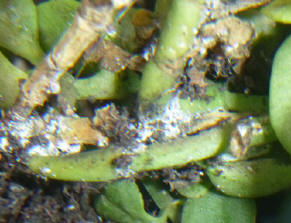 |

|
mealy bugs (which look like bits of lint) burrow
into leaf axils. Spray pests with rubbing alcohol diluted 50% with
water.
Or bug clear at a lower dose than they say |
Prevent infestations by giving succulents excellent air circulation. Aphids
and thrips like flower buds; scale tends to colonize stems; Scale can be scraped off, Isolate
any infested plants immediately, lest the pests spread, and thoroughly clean
the area. Mould may be a problem in humid climates; keep succulents as dry
as possible (which sounds easy but of course isnít).
If you are following healthy practices for your succulents as indoor house
plants (good watering, well draining soil, sunlight, airflow and
temperature), bugs should not be a problem.
ButÖ they often are !!!!!!!!!!!!!!!!
Youíll generally get gnats if your soil stays too wet. Gnats are generally
avoidable by using a well draining soil mix and allowing your soil to dry
out between watering. Ordinary fly spray will kill these, use very sparingly
If you get mealy bugs, youíll want to spray them with rubbing alcohol and
pour alcohol over the soil to kill any eggs they may have laid.
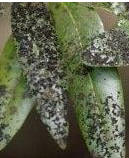 |
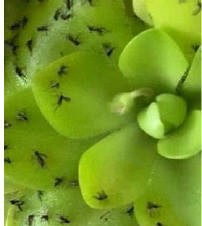
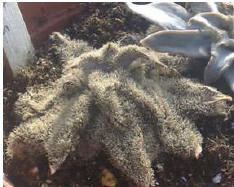 |
If pests seem to be winning, take cuttings from
unaffected growth and establish them in fresh soil. Discard the diseased
plant, soil and all, and clean the pot before reusing |
Types of containers
Plants with shallow roots or that tend to rot faster do best in low or
unglazed containers. Plants with leggy roots or those that require more
water thrive in deep containers made of glazed, ceramic, fibreglass or
plaster, you can use succulents in wood frames and boxes, logs and metal
vessels, glass cylinders and handmade pottery.
The same thing goes for a container without a hole for water to drain out.
Air flow is especially important for succulents in the winter to help keep
the soil mostly dry and the plant breathing again, make sure you are using a
well draining soil as well.
Glass containers generally arenít a great long term potting solution for
succulents, especially during the winter. Succulents do not like to be
sitting in soggy soil so a glass jar (or terrarium) is not going to make
your succulent happy. This seems to especially cause problems in the winter
when succulents need even less water than normal. Often succulents will get
bugs or diseases from having soil that is too wet.
If you can help it, I really recommend staying away from glass unless you
know your succulent really well and are confident in your watering skills.
The best pots to use indoors are terracotta and glazed ceramics, they
provide great air flow and allow the soil to dry out easily. I always advise
people to avoid glass containers (or anything that doesnít drain)
But if you just love the glass containers so much and you still can't resist
them then it is possible to have your succulents in them, you need to be
very careful with how much water you give them, always measure out how much
water you need before you go pouring it on and make sure you only put in
enough water to just get the soil damp, this way you can control the amount.
Please feel free to email us with your problems , we will endeavour to reply
within a few days
suzie.hembury@gmail.com
|









